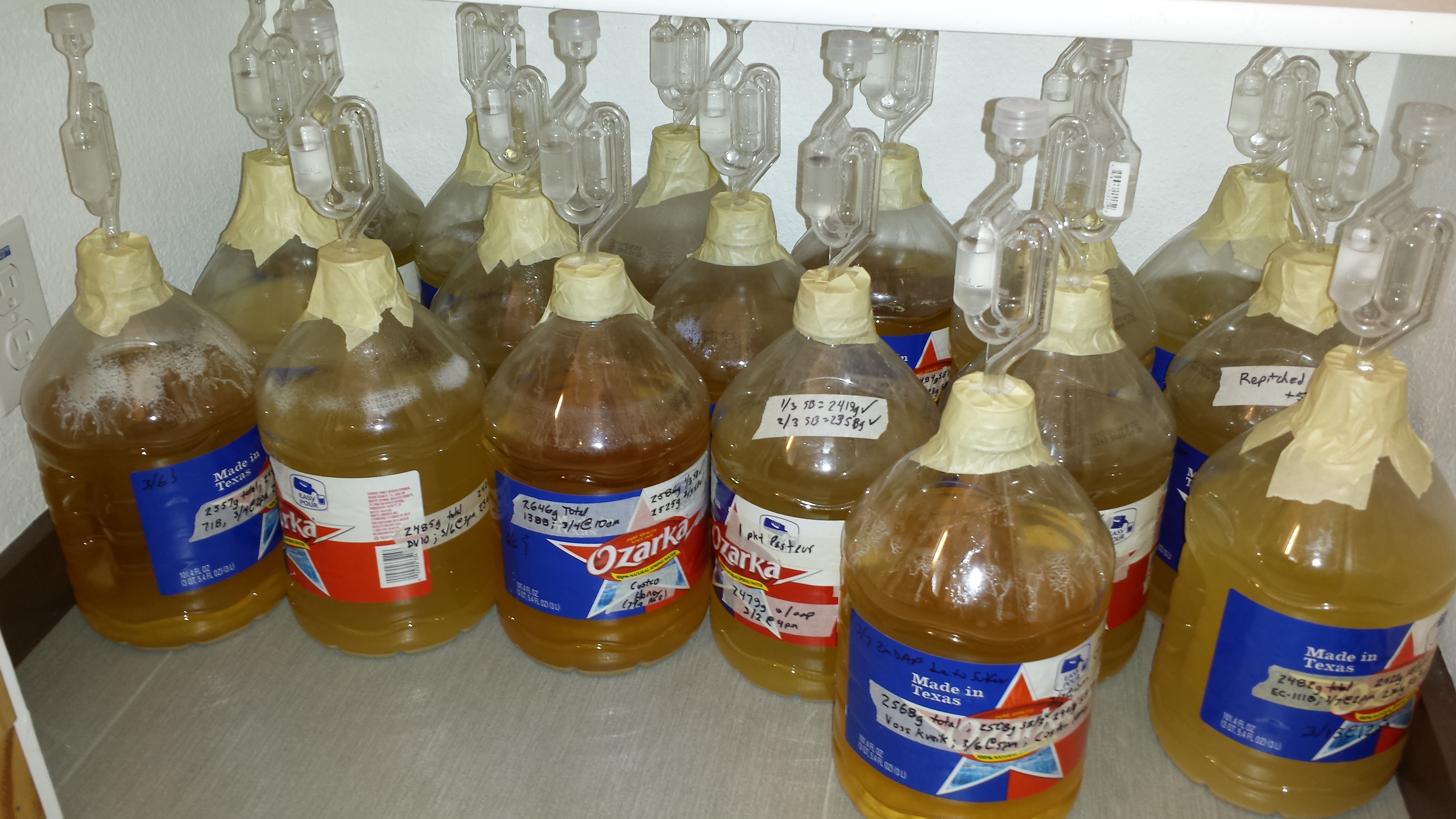NeverDie
Well-Known Member
Did ya end up doing a batch w/D47?
Here's a thread I came across from others doing Mead with D47 ---
http://www.gotmead.com/forum/showthread.php/8633-Lalvin-ICV-D-47-yeast
Yup, D47 is under test.

Did ya end up doing a batch w/D47?
Here's a thread I came across from others doing Mead with D47 ---
http://www.gotmead.com/forum/showthread.php/8633-Lalvin-ICV-D-47-yeast
Back to the main topic of the yeast testing: by when do I need to move it off the lees? Some, like 1388, seem to have already flocculated clear enough to read a newspaper, but at the same time they may (?) still be bubbling at a very slow rate. Is a non-changing SG the only reliable guideline for deciding?
I had read that 71B in particular can develop off flavors if left on its lees for "too long"--I think one source said in as little as 3 weeks--and so I wasn't sure 1. is it true?, 2. if so, how long is too long?, and 3. when to start the clock on measuring that? As usual, using just google, there's lots of conflicting information that one can find.
![Craft A Brew - Safale S-04 Dry Yeast - Fermentis - English Ale Dry Yeast - For English and American Ales and Hard Apple Ciders - Ingredients for Home Brewing - Beer Making Supplies - [1 Pack]](https://m.media-amazon.com/images/I/41fVGNh6JfL._SL500_.jpg)











When I asked about racking and lees @Yooper told me when they're 1/4 inch.
Gotta pic of this big test in action - gal container city! [emoji57]
Yes, Kveik was selectively evolving in higher og worts and therefore is accustomed to high level of nutrients. I cannot say how much but lower gravity beer wort can already be not enough. Honey therefore really needs to be bumped with nuts.Even with the extra nutes, the Hornindal Kveik quickly went sulfurous on me, and so I dumped it. It was a straight pitch direct from an Omega labs pouch that I had picked up at the local homebrew store yesterday. It had a February 15 mfg. date.
This is actually rather consistent with my prior experience for Hornindal, and now I think pretty much confirms it. I've been able to get Hornindal to work in the past, but only if I first made a highly aerated starter, which I didn't do this time. It's an interesting yeast, but since it's not a dry yeast anyway, I'm not going to try it again for this particular roundup. I still have the Voss Kveik included though. The Voss is still a good yeast and, at least in my experience, is not as high maintenance as the Hornindal.
I've been thinking about your eventual analysis of the test results. When I submit my ciders to competitions I look forward to the score sheets coming back, with comments from certified judges. They always find something that is so subtle (to me) that I'd never have known otherwise. I've adjusted my processes as a result of the feedback that I've received.
Now granted that's for a finished product, not the "as fermented" young cider. But my point is that there are people who have been trained and certified in tasting stuff, and I'm not.
Case in point - I had a cider that was so good a friend's SO offered to buy a sixer from me. That's a pretty high compliment. Yet a comp judge said it smelled of baby vomit (butyric acid) and scored me very poorly.
OK, so the point of this (yeah there is one) is that you've mentioned in another thread that there are wine tasting parlors everywhere around you. It might be worth your while to visit them and see if there are any mead or wine certified judges around who might be willing to give you a professional opinion on your meads when the time comes.
Just tossing out an idea...


Good job!You know you gotta drink all that?

Major mead throwdown! Dig it [emoji111]As requested, here's a photo:
View attachment 617753
Not much to look at, but there it is. 17 bottles under airlock. Two more bottles (M05 and M31) will be joining them after their second sugar break is reached.
In case you're wondering, the tape is to anchor the stoppers and keep them from popping out and also to ensure what I hope is an airtight seal. These are 3L springwater bottles made out of PETE plastic.
I hadn't asked about judges, but yesterday at Austin Homebrew Supply store, I asked if they knew of any mead clubs. They didn't. Their suggestion was to contact either Sherwood Forrest (a stationary medieval re-enactment carnival) or possibly the Society for Creative Anachronisms. Hmm... so apparently that's where making mead fits into the modern landscape: an anachronism of interest to people who dress in chainmail and go jousting.LOL.
And here I thought it was the drink of the gods. Well, still do.
Again, thank you very much for going through the effort and especially for putting it all online. This is really useful for everyone.Summary Status of Room Temperature Dry Yeast Mead Trial
The 15 dry yeasts currently under trial are (in no particular order):
Of these, all are under airlock, except for the last two, which just started fermenting yesterday.
- DV10,
- S-04,
- EC-1118 (two separate batches: one rehydrated using GoFerm and the other direct pitched),
- Belle Saison,
- K1V-1116,
- D21,
- Red Star Cote des Blancs,
- D47,
- Red Star Premier Blanco,
- Fleishmann's,
- 71B,
- Red Star Premier Cuvee,
- Fresco,
- Mangrove Jack's M31, and
- Mangrove Jack's M05.
The honey used is Costco clover honey and the water used is Ozark spring water. Yes, I realize Costco honey may fall short of the ideal (local honey), but I deem it good enough for the purpose of this experiment.
The 3 liquid yeasts (for comparison purposes) are:
All three are under airlock.
- 1388,
- Wyeast Sweet Mead, and
- Voss Kveik.
These are all traditional meads consisting of just honey, spring water, yeast, and nutrients. All of them are fermenting at room temperature (which is around 72F, give or take).
As for nutrients, I am following the newer 6b DLNA protcol here: https://denardbrewing.com/blog/post/brays-one-month-mead/
The OG on all of them was 1.080, except for M05 and M31, which have OG of 1.105 (as will all future tests). If I had it to do over again, based on recent reading, I'd trial them all with an OG of 1.105.
The plan is to let them all ferment to completion, filter out the failures, and then attempt to rank the non-failures.
I don't mind if there are failures. I'm just hoping that, at the end of the day, there are some attractive non-failures remaining after the failures are eliminated.
If you think I missed a really good dry yeast for making mead, then please post and I'll try to fit it in if it seems warranted. That said, I have to draw the line somewhere, and the above list seems to include the most frequently named mead yeasts that I've come across in my reading.
Do you live in/around Austin?
Again, thank you very much for going through the effort and especially for putting it all online. This is really useful for everyone.
I made one mead with cbc1 at 30c during the summer which got a bit hot, but at normal temperature it might be a good choice,choice, so you might want to look at it as well. I am having california lager from mj fermenting at the moment looking and tasting promising, maybe that would be a good idea as well.
Do you live in/around Austin? One of my friends (and a longtime member here but now too busy to be on the forum much) has a meadery called Meridian Hive. He’s not there now, as he’s at the Mazer’s Cup, but they have a tap room open on weekends, and I bet he/they could give you some pointers and taste your mead. They have an awesome staff, and it’s a great place to sample meads.

Did you start your Fresco cyser yet? I started my Fresco cyser early this morning. I know I'm jumping the gun a bit, without knowing how the fresco traditional mead has turned out, but I figure it's meant for cider, and I have extra vials of Fresco, so....What's the Fresco's aroma like so far? I hope to start a cyser with mine tomorrow.
